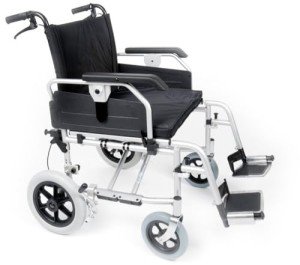Bariatric Wheelchair Seat Width
Seat Width
Having the correct seat width is very important to wheelchair users who invest longer periods in their chairs. Too narrow a seat will cause pressure on the hips and thighs which could result in sores or pressure points. Having too large a seat can likewise make it challenging for the user to reach the hand rims to move themselves or maneuver in small spaces.
To determine the appropriate seat width a person would sit on a chair normally and have their measurement taken across their lap at the widest point which is generally their hips. A wheelchair measuring tape can be utilized to determine this, however a backyard stick is chosen as it avoids individuals from covering the tape around their hips which would give an inaccurate result.
The basic wheelchair seat width is 16" (narrow grownup), 18" (standard adult), and 20" (broad adult). For bariatric clients, a 24" seat is readily available. This sturdy additional broad bariatric wheelchair from Medline includes swing-away footrests, a carbon steel frame with rust- and chip-resistant chrome plating, and easy-to-clean vinyl upholstery. It has a weight capacity of 500 pounds.
Seat Depth
Typically, the seat depth of a bariatric wheelchair was added 2" to the measurement taken at the user's largest point (typically their hips). This was suggested to accommodate additional layers of clothes that might be used during winter. Nevertheless, this practice is ending up being less typical as wheelchair users have the ability to spend more time inside your home and are not wearing long coats. This makes the seat depth of a chair less crucial when choosing a bariatric wheelchair. However, it is still essential to choose an alternative that offers sufficient assistance for larger users.
The Medline folding extra wide bariatric manual wheelchair includes a comfy 24" seat width and a sturdy slide tube silver vein frame. It also has an adjustable axle and tool-free raising legrests.
Seat Height
When it concerns determining the appropriate wheelchair seat width you ought to constantly measure from the user's best point which is normally their hips. You will also require to think about whether the user is going to be wearing a winter season coat as this may add 2" to the width needed.
When a wheelchair is in usage it must only be run on level surface areas with the wheel locks totally engaged. This is to prevent the chair from having the ability to move inclines that are 10 degrees or greater. It is likewise crucial to bear in mind that any activity that may shift the center of gravity in the chair need to be done with care. This includes grabbing items that need the individual to lean out of their seat or attempting to stand from it.
Whenever you have the chair in usage it is suggested that you regularly examine it for damage and lube any locations that are deemed necessary. For instance, the casters must be lubed by eliminating the caster fork and utilizing a multi-purpose grease to apply to the caster stem bearings. Likewise, the foot plates can be adjusted by loosening the bolt and then moving them to the wanted position. This permits the feet to sit conveniently on the footplate and prevents any pressure points from forming. This can be really uneasy for the user and if left unattended, can cause pressure sores.
Weight Capacity
Bariatric wheelchairs are created to support more weight than standard wheelchairs. This makes them tougher and much better geared up to handle falls. They are also usually bigger and broader, making them less maneuverable in tight spaces than standard wheelchairs. They require automobiles with special ramps and lifts to pack them, as well as chauffeurs who understand how to finest transport them from one place to the next.

When choosing a wheelchair, consider its weight capacity as it will be the primary determining factor in whether it will accommodate your passenger's requirements. The weight capacity of the chair is typically listed as a static load, meaning that it shows the amount of weight the chair can conveniently hold while standing still. However, some producers also note an active load that is based upon a drop test and can mimic the impact of someone sitting down in the chair. Learn Alot more may be a more dependable measurement of the weight limit, depending on your needs.
If you plan to carry out activities that shift your center of mass in the seat (such as reaching for things), make certain to have front casters pointed in a forward instructions and wheel locks engaged so the chair will not tip over. Also, examine that casters are lubed regularly to avoid excessive wear and abrasions. The lubrication procedure includes eliminating the fork, separating the caster from the wheel, and greasing the caster stem bearings with high-quality multi-purpose grease.
